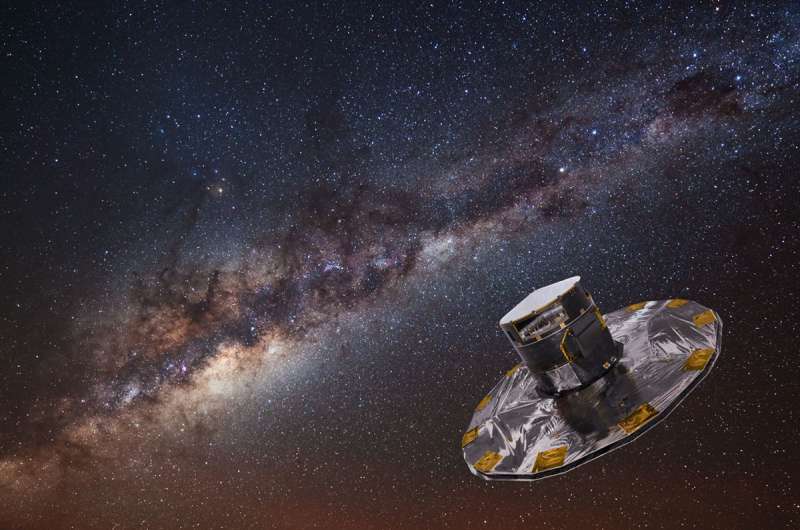Missing stars in the solar neighbourhood reveal the sun's speed and distance to the centre of the Milky Way galaxy

Using a novel method and data from the Gaia space telescope, astronomers from the University of Toronto have estimated that the speed of the Sun as it orbits the centre of the Milky Way Galaxy is approximately 240 kilometres per second.
In turn, they have used that result to calculate that the Sun is approximately 7.9 kiloparsecs from the Galaxy's centre—or almost twenty-six thousand light-years.
Using data from the Gaia space telescope and the RAdial Velocity Experiment (RAVE) survey, Jason Hunt and his colleagues determined the velocities of over 200,000 stars relative to the Sun. Hunt is a Dunlap Fellow at the Dunlap Institute for Astronomy & Astrophysics, University of Toronto.
The collaborators found an unsurprising distribution of relative velocities: there were stars moving slower, faster and at the same rate as the Sun.
But they also found a shortage of stars with a Galactic orbital velocity of approximately 240 kilometres per second slower than the Sun's. The astronomers concluded that the missing stars had been stars with zero angular momentum; i.e. they had not been circling the Galaxy like the Sun and the other stars in the Milky Way Galaxy;
"Stars with very close to zero angular momentum would have plunged towards the Galactic centre where they would be strongly affected by the extreme gravitational forces present there," says Hunt. "This would scatter them into chaotic orbits taking them far above the Galactic plane and away from the Solar neighbourhood."
"By measuring the velocity with which nearby stars rotate around our Galaxy with respect to the Sun," says Hunt, "we can observe a lack of stars with a specific negative relative velocity. And because we know this dip corresponds to 0 km/sec, it tells us, in turn, how fast we are moving."
Hunt and his colleagues then combined this finding with the proper motion of the supermassive blackhole known as Sagittarius A* ("A-star") that lies at the centre of the Galaxy to calculate the 7.9 kiloparsec distance.
Proper motion is the motion of an object across the sky relative to distant background objects. They calculated the distance in the same way a cartographer triangulates the distance to a terrestrial landmark by observing it from two different positions a known distance apart.
The result was published in Astrophysical Journal Letters in December 2016.
The method was first used by Hunt's co-author, current chair of the Department of Astronomy & Astrophysics at the University of Toronto, Prof. Ray Calberg, and Carlberg's collaborator, Prof. Kimmo Innanen. But the result Carlberg and Innanen arrived at was based on less than 400 stars.
Gaia is creating a dynamic, three-dimensional map of the Milky Way Galaxy by measuring the distances, positions and proper motion of stars. Hunt and his colleagues based their work on the initial data release from Gaia which included hundreds of thousands of stars. By the end of its 5 year mission, the space mission will have mapped well over 1 billion stars.
The velocity and distance results are not significantly more accurate than other measurements. But according to Hunt, "Gaia's final release in late 2017 should enable us to increase the precision of our measurement of the Sun's velocity to within approximately one km/sec, which in turn will significantly increase the accuracy of our measurement of our distance from the Galactic centre."
More information: Jason A. S. Hunt et al. DETECTION OF A DEARTH OF STARS WITH ZERO ANGULAR MOMENTUM IN THE SOLAR NEIGHBORHOOD, The Astrophysical Journal (2016). DOI: 10.3847/2041-8205/832/2/L25
Journal information: Astrophysical Journal Letters , Astrophysical Journal
Provided by University of Toronto





















